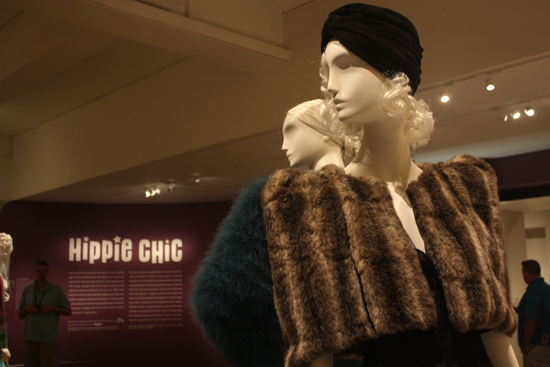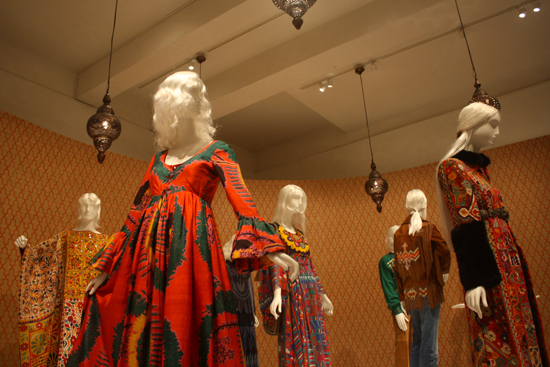Hippie Chic
MFA celebrates ’60s and ’70s fashion

The psychedelic Hippie Chic exhibition is on view at the MFA through November 11. Photos by Tom Vellner
They rebelled against the establishment, reveled in a culture of sex, drugs, and David Bowie, and in their own way, revolutionized fashion. We’re talking hippies, and their counterculture couture is the subject of what may be the Museum of Fine Arts’ trippiest exhibition ever.
Titled Hippie Chic, this vibrant display of 1960s and 1970s hippie-era fashion explores how a generation redefined couture and shaped the minds of youth—and designers—across the globe. Comprising 54 ensembles, the outfits on display here are not merely a collection of bell-bottoms, tie-dyed T-shirts, and fringe vests. The show illustrates how a generation’s insistence on creating its own style influenced up-and-coming designers as well as top fashion houses.
On entering the Lois B. and Michael K. Torf Gallery, you’ll see four thin platforms, each resembling a 1960s television variety show stage, reminiscent of the Beatles’ first performance on The Ed Sullivan Show in 1964. Dozens of mannequins modeling an eclectic mix of ensembles stand on the platforms, divided into five categories: the ethnic hippie, the craft hippie, the trippy hippie, the retro hippie, and the fantasy hippie. The trippy hippies stand on several rotating circular platforms with brightly colored shag rugs on top and kaleidoscopic patterns projected onto the floor.
An adjacent description provides information about each category and its impact on the hippie movement. For example, the craft hippie section, featuring mannequins dressed in star-frame glasses, full-sleeve patchwork dresses, and halo headbands, notes hippies’ insistence on creating their own clothes—a rejection both of consumerism and of anything that smacked of “establishment” clothing. As Hippie Chic makes clear, the late ’60s and early ’70s were an unprecedented era in fashion history: haute couture designers from Paris, London, and New York weren’t dictating what to wear, but instead were copying what young people had dreamed up.
Exclamations of “We used to wear these!” or “Do you remember them?” were heard on a recent afternoon as groups of 60- and 70-something women stopped and gazed at outfits designed by the likes of Betsey Johnson, Yves Saint Laurent, and their British counterparts Ossie Clark and Celia Birtwell. Even younger visitors appeared fascinated by the psychedelic and retro styles, perhaps searching for inspiration for their own closet.

The dazzling costumes are offset by a soundtrack of ’60s and ’70s hits from a vintage jukebox. Music from the Kinks, Led Zeppelin, and the Rolling Stones fills the gallery, adding an additional “groovy” factor to the show. Music, like the ensembles themselves, is divided into five categories: cool, far-out, trippy, groovy, and outta sight. Visitors were clustered around the jukebox, grinning as they decided what hit song should play next.
Given the fact that halo headbands, floral prints, and Lennon-style sunglasses are being sold by popular clothing stores like Urban Outfitters and Free People and are commonly seen on a stroll down Newbury Street, the hippie look seems to be alive and well. Take a trip to the MFA’s Hippie Chic and learn how it all began. The exhibition is far out, man.
Hippie Chic is on view at the Museum of Fine Arts, 465 Huntington Ave., Boston, through November 11. The museum is open Monday, Tuesday, Saturday, and Sunday from 10 a.m. to 4:45 p.m., Wednesday to Friday from 10 a.m. to 9:45 p.m. Admission is free with BU ID and $25 for adults. By public transportation, take the Green Line E trolley or 39 bus to the Museum of Fine Arts stop or the Orange Line train or bus routes 8, 47, or CT2 to the Ruggles stop.
Tom Vellner can be reached at tvellner@bu.edu; follow him on Twitter at @tomgvellner.
Comments & Discussion
Boston University moderates comments to facilitate an informed, substantive, civil conversation. Abusive, profane, self-promotional, misleading, incoherent or off-topic comments will be rejected. Moderators are staffed during regular business hours (EST) and can only accept comments written in English. Statistics or facts must include a citation or a link to the citation.